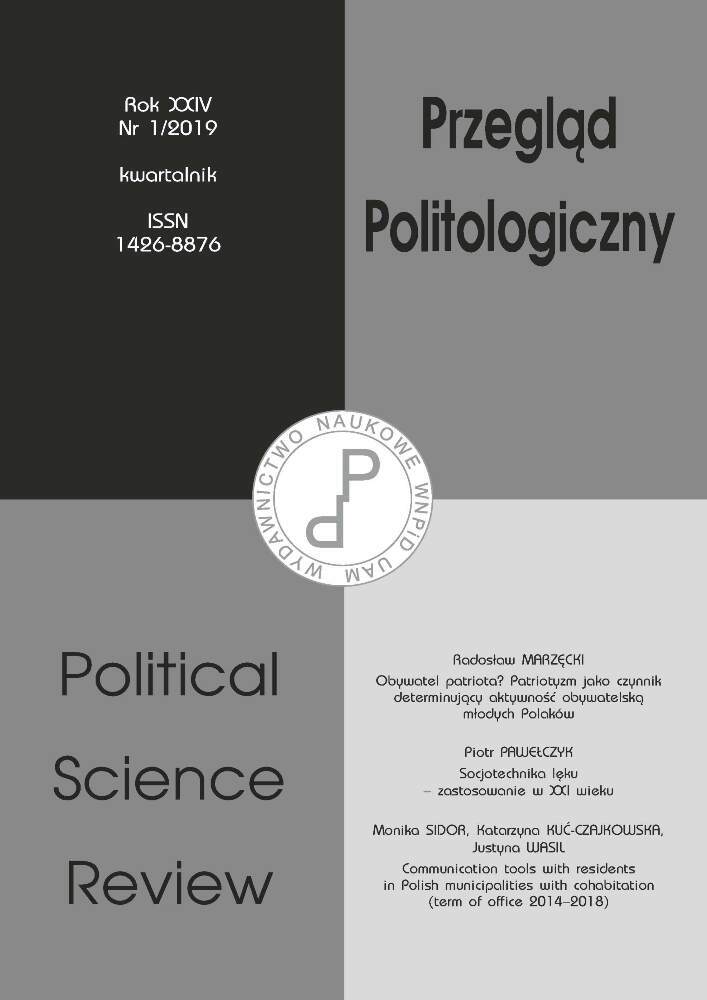Abstract
This article aims to evaluate protest policing in the austerity-driven Slovenia and verify the analytical effectiveness of a tool for measuring protest policing. Therefore, the paper critically discusses and modifies Donatella della Porta and Herbert Reiter’s theoretical framework consisting of the escalated force and negotiated management antinomic ideal types, and then applies it to examine the Slovenian case. The research draws on a qualitative method of sources analysis based on a conceptual qualitative content analysis to solve the problems of what was the Slovenian model of protest policing in times of austerity? And why did it have a particular shape? The study diagnoses Slovenia as having the negotiated management mode of protest policing with the elements of the escalated force model. This mode stems from the organizational dynamics of the Slovenian National Police which typifies with the dialectic of decentralization and hierarchical submission in police units, the effectively used possibilities to coordinate the different groups operating within protesting crowds, and certainty about the purposes of the intervention.
References
Arbutina Z., glb (2012), Slovenia - back to reality, forth to austerity, 17.12.2012, “DW”, http://www.dw.com/en/slovenia-back-to-reality-forth-to-austerity/a-16459181, 10.02.2018.
CBC News (2012), Anti-austerity Slovenia protesters clash with police: Has worst recession of 17 eurozone countries, 01.12.2012, “CBC News”, http://www.cbc.ca/news/world/anti-austerity-slovenia-protesters-clash-with-police-1.1298756, 10.02.2018.
della Porta D., Reiter H. (1998), The Policing of Protest in Western Democracies, in: Policing Protest: The Control of Mass Demonstrations in Western Democracies, eds. D. della Porta, H. Reiter, University of Minnesota Press, Minneapolis, London.
della Porta D., Reiter H. (2006), The Policing of Global Protest: The G8 at Genoa and its Aftermath, in: The Policing of Transnational Protest, eds. D. della Porta, A. Peterson, H. Reiter, Ashgate Publishing Limited, Hampshire-Burlington.
Durić D., Žibret D. (2017), Respond to query 630-36/2017/4: Slovenian National Police. Register: 630-36/2017/4(262-03) [in the author’s records].
Finlay Ch. J. (2017), The concept of violence in international theory: a Double-Intent Account, “International Theory”, vol. 9, no. 1.
Flesher Fominaya C. (2017), European anti-austerity and pro-democracy protests in the wake of the global financial crisis, “Social Movement Studies”, vol. 16, no. 1.
Kirn G. (2013a), A ghost is haunting Slovenia, the ghost of revolution!, 16.02.2013, “New Socialist”, http://www.newsocialist.org/679-a-ghost-is-haunting-slovenia-the-ghost-of-revolution, 10.02.2018.
Kirn G. (2013b), Social Uprising in Slovenia against Neoliberal Austerity Measures, 25.02.2013, “Global Research”, http://www.globalresearch.ca/social-uprising-in-slovenia-against-neoliber-al-austerity-measures/5324218, 10.02.2018.
Krašovec P. (2013), The Slovenian Uprising in Retrospect, “Debatte: Journal of Contemporary Central and Eastern Europe”, vol. 21, no. 2-3.
Lopez A. (2012), Spain’s anti-cuts Protests Violently Broken up by Police, 27.09.2012, “World Socialist Website”, http://projectcensored.org/riot-police-violently-break-up-anti-austerity-protests-in-spain/, 10.02.2018.
Maza C. (2013a), Rough guide to Slovenian protests, 2012/2013, 04.02.2013, “Cafebabel”, http://www.cafebabel.co.uk/society/article/rough-guide-to-slovenian-protests-20122013.html, 10.02.2018.
Maza C. (2013b), Slovenia Joins Euro Zone Anti-Austerity Protests, 10.02.2013, “Policy.Mic”, https://mic.com/articles/25332/slovenia-joins-euro-zone-anti-austerity-protests#.bVS7ZwHT0, 10.02.2018.
Mekina B. (2012), Slovenia: The placid people’s revolt, 14.12.2012, “Vox Europ”, http://www.voxeurop.eu/en/content/article/3163301-placid-people-s-revolt, 10.02.2018.
Mekina B. (2014), EU elections to test Slovenia’s handling of crisis, 26.02.2014, “Euobserver”, https://euobserver.com/eu-elections/123150, 10.02.2018.
Millen F., Stephens M. (2011), Policing and accountability: the working of police authorities, “Policing and Society”, vol. 21, no. 3.
Ministry of the Interior Police (2017), Task and Goals, https://www.policija.si/eng/index.php/about-thepolice/tasksandgoals.
Novak M., Radosavljevic Z., Heinrich M. (2012), Slovenia police arrest 141 in violent anti-aus¬terity protests, 04.12.2012, “Reuters”, http://www.reuters.com/article/us-slovenia-arrests-idUSBRE8B30QM20121204, 10.02.2018.
Perković A. J., Ucakar T. (2017), Economic crisis and the crisis of national identity in Slovenia: toward a new notion of social order, “Nationalities Papers: The Journal of Nationalism and Ethnicity”, vol. 45, no. 2.
Policija (2013), Analiza aktivnostipolicije obprotestih na obmocju Republike Slovenije [in the author’s records].
Punch K. F. (2014), Introduction to Social Research: Quantitative and Qualitative Approaches, 3rd edition, Sage, London.
Rak J. (2017), Intrastate, Regional, and Colonial Contributions to Post-2008 Cultures of Political Violence, “Polish Political Science Yearbook”, vol. 46, no. 1.
Rak J. (2018a), From Mobilization to Demobilization: Dynamics of Contention in the Austerity-driven Slovenia, “Środkowoeuropejskie Studia Polityczne”, vol. 3.
Rak J. (2018b), Theorizing Cultures of Political Violence in Times of Austerity: Studying Social Movements in Comparative Perspective, Routledge, London-New York.
Razsa M., Kurnik A. (2012), The Occupy Movement in Zizek’s hometown: Direct democracy and a politics of becoming, “American Ethnologist”, vol. 39, no. 2.
RT (2013), Anti-austerity protests rock Slovenia as fears of bailout grow, 27.04.2013, “RT”, https://www.rt.com/news/austerity-protests-bail-out-504/, 10.02.2018.
Santopadre M. (2012), Slovenia: proteste antiausterity e scontri a Maribor e Lubiana, 02.12.2012, “Contropiano”, http://contropiano.org/news/internazionale-news/2012/12/01/slovenia-proteste-antiausterity-e-scontri-a-maribor-e-lubiana-012989, 10.02.2018.
Shea J. O. (2015), The Criminalisation of Social Protest in the Republic of Ireland: The Movement against Economic Austerity and Water Privatization. The Jobstown Aftermath and the ECHR, 27.02.2015, “Global Research”, February 27, http://www.globalresearch.ca/the-criminalisation-of-social-protest-in-the-republic-of-ireland-the-movement-against-economic-austerity-and-water-privatization/5433673, 10.02.2018.
Tilly Ch. (2006), Regimes and Repertoires, The University of Chicago Press, Chicago-London.
Toplišek A., Thomassen L. (2017), From Protest to Party: Horizontality and Verticality on the Slovenian Left, “Europe-Asia Studies”, vol. 69, no. 9.
Wada T. (2016), Rigidity and Flexibility of Repertoires of Contention, “Mobilization: An International Quarterly”, vol. 21, no. 4.
Whelan Ch. (2017), Security networks and occupational culture: understanding culture within and between organisations, “Policing and Society”, vol. 27, no. 2.

